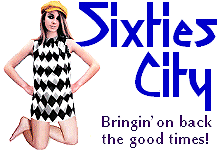


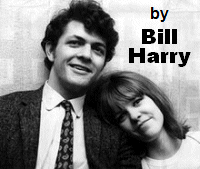
 |
 
|
 |
| Presented
here, in his own words, is the definitive story of one of the Sixties' seminal
music newspapers - providing a fascinating and unique personal insight into
the early days of the 'British Beat Boom' and the events, personalities,
facts and legend surrounding the birth of the greatest musical revolution
the world has ever known.
Bill Harry was the founder of the Liverpool music paper which chronicled
the groups and venues responsible for the 'Mersey Sound', the publication
which was to give its name to the Sixties phenomenon and musical era that
has since become almost universally known as 'Mersey Beat'.
Early in 1960 John Lennon, Stuart Sutcliffe, Rod Murray and I had been to Liverpool University to listen to a poet called Royston Ellis. We later retired to 'Ye Cracke' pub in Rice Street to discuss the evening. The topic of conversation was that Royston was copying the San Francisco poets rather than composing works in the British tradition. We felt that any creative person should really base their work on their own experiences rather than copying someone else’s and the discussion led us to decide to work creatively on what we knew best – and that was life in Liverpool. We decided to call ourselves ‘The Dissenters’ and made a vow that we would work creatively to make Liverpool famous. |
Bill has also
provided more than 240 personally written pieces on many aspects, events
and personalities of the Sixties. Click on the logo to see the full list of articles available. |
|
John would do it with his music, Stuart and Rod with
their painting and me with my writing. In some ways I suppose that could
have been the spark that ignited my creation of 'Mersey Beat'. The four
of us also used to hang around a coffee bar called 'The Jacaranda' in Slater
Street, run by an ebullient character called Allan Williams. On the top
floor attic of the building, which housed the 'Jac', was a young man selling
second-hand albums. I used to chat to him and bought a copy of the ‘Picnic’
soundtrack. He was aware that I’d been assistant editor of 'Pantosphinx',
the University charity magazine, and told me that Frank Hesselberg, who
owned the Frank Hessy music store, had asked him to edit a magazine called
‘Frank Comments’ but he didn’t know how to go about it – would I do it with
him? He introduced me to Mr Hessy and I got to work - designing it, writing for it and arranging for it to be printed at a local printing works, James E. James. I had a love of both writing and artwork and combined the two in creating magazines. Around that time I’d designed a magazine called 'Storyville/52nd Street' in the same format as the Hessy magazine. However, my taste in music had been turning from jazz to rock ‘n’ roll. John Ashcroft, a fellow student, had introduced me to Elvis Presley records and I used to go to a friend’s house to listen to Buddy Holly singles. With John and Stuart also being in a group, together with Paul and George from Liverpool Institute next door to the art school, I was more and more intrigued by this exciting sound which didn’t seem to get much airplay on BBC radio. We’d book John’s group for our Art College dances and at 'The Jac' I’d become friendly with members of 'Rory Storm & The Hurricanes' and 'Cass & The Cassanovas'. I’d always carried little notebooks with me to write down information and began taking note of the number of local groups I’d heard about. At one time I wrote to the Daily Mail saying that Liverpool was like New Orleans at the turn of the century, but with rock ‘n’ roll instead of jazz. Of course, nothing ever came of that. There was no information about local groups in the Merseyside newspapers so, together with my girlfriend Virginia, I began to develop the idea of a ‘what’s on of music in Liverpool.’ Of course, being a student on a grant, I didn’t have enough money to produce it. Then I was approached by a friend, Dick Matthews, who had told an acquaintance of his, Jim Anderson, that I wanted to produce a publication. Dick introduced me to Jim and I described the project to him. He asked me how much I needed and I told him £50. He agreed to lend me the money and also secured me an attic room above David Land, the wine merchants, in Renshaw Street. Virginia gave up her job and became a full-time member of the newspaper. Jim and Dick helped us to move into the tiny top-floor room with Jim also providing us with a desk, chair and typewriter. |
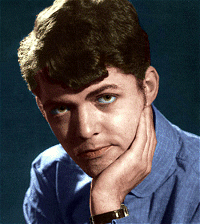 |
Dick had a camera and became our first photographer.Money,
of course, was tight - the office cost £5 a week, Virginia had a salary
of £2.10s and I took no wages at all, but lived on my grant from a Senior
City Art Scholarship. The first person that I approached to write for me was John. I’d originally discovered his ability as a wordsmith when we were sitting together in 'Ye Cracke' one evening. I’d heard rumours that he wrote poetry and asked if I could see a sample. He was, initially, reluctant to discuss it then gave way and showed me a poem he had on folded scraps of paper in his pocket. I found that it was full of humour, double entendres and was so essentially 'British'. No San Franciscan poet could have written this! I was later to ask John if he could write me a piece for my forthcoming publication about his group.In the meantime, Virginia and I were preparing the debut issue. Generally, after I’d taken Virginia home in the evening, I’d return to the office and work through the night - often going out for a break at four in the morning to the Pier Head where I’d get a cup of tea and a hot pie. The time came for me to think of a name for the publication and I was racking my brains – it was to be a ‘what’s on of Merseyside music’ but what should I call it? It was around 2 o'clock one morning when I sat back and began to work out what the name should be. One decision I had to make was regarding the area I’d be covering. I thought that, apart from Liverpool, I’d cover ‘over the water’ – The Wirral, Birkenhead, New Brighton, because there was a lot of activity there with groups. I also decided to include Crosby and Southport because there were also venues there for the groups. Warrington, Widnes and Runcorn would also be part of my 'beat'. I began to visualise in my head a map of the area I’d be covering. I pictured the entire Merseyside conurbation and, suddenly, in the visualisation, I saw a policeman – a policeman’s beat! The entire area of Merseyside would be my 'beat' – the 'Mersey Beat'! At that time there was no such term as ‘beat group’ - that only came later, after 'Mersey Beat' had been established as a paper. The groups were rock ‘n’ roll groups and the venues were jive hives – jive and twist were the most popular terms, then, to describe the music. I arranged for James E. James to print the newspaper but, due to costs of having metal blocks made, I couldn’t use many photos in the first issue. 'The Widnes Weekly News' lent me a block they’d had made of Gene Vincent with Terry Sharrock and Mary Larkin, the two girls who worked at The Jacaranda, and I used that as the front cover photo. To illustrate adverts I used blocks of cartoons from my art school mates which I’d originally used in 'Pantosphinx'. |
|
Owl George 'ee be a farmer’s lad With mucklekak and cow 'Ee be the son of ‘is owl dad But why I don’t know how .'Ee tak a fork and bale the hay And stacking-stook he stock And lived his loif from day to day Dressed in a sweaty smock. One day he marry be To Nellie Nack the Lass And we shall see what we shall see A-f***ing in the grass. Our Nellie be a gal so fine All dimpled wart and blue. She herds the pigs, the rotten swine, It mak we wanna spew! Somehaps, perchance, 'ee’ll be a man But now I will unfurl Owl George is out of the frying pan ‘Cos ee’s a little girl. John Lennon |
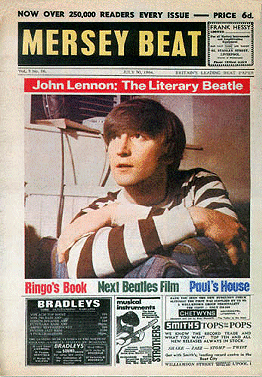 |
The article on page 4, ‘Swinging Cilla’, was responsible for Cilla Black’s
stage name as the second paragraph begins with the words ‘Cilla Black is
a Liverpool girl who is starting on the road to fame'. I remember going
down to the State Ballroom one evening when I was putting the first issue
together and asking Cilla if she had the fashion column that she had promised
me. She was with her mate, Pat Davies, and 'Cass & The Cassanovas' were
on stage. When I got back to the office I began working on the copy for
the first issue and began to type out a story on Cilla. When it came to
putting down her surname my mind went blank - I knew it was a colour, but
forgot which one. I took out the piece of paper with Cilla’s fashion column
on it (which was published in Issue No. 2) but she hadn’t signed it. The column was all about colours in fashion and went from white to black. Looking at it I decided on the 'black' but I was wrong - her name was Cilla White! After Mersey Beat was published, Cilla came into the office and told me that I’d got her surname wrong – but she liked it so much she decided to call herself Cilla Black from then on! When we were sitting in 'The Jacaranda' shortly before The Beatles set off on their second trip to Hamburg, John handed me some scraps of paper – it was the piece I’d asked him to write about The Beatles' origins. It was something totally unexpected and its sheer wackiness delighted me. I immediately ordered him coffee and jam toast! The piece appeared on page 2 of the first issue (right), which was originally published on July 6th 1961. The humour of it appealed to me. It was the time of 'The Goons' (who regularly said 'you rotten swine') and at Junior Art School I'd been involved with some friends in what we called the 'Natty Nut Society'. I was also interested in the nonsense novels of Stephen Leacock (as was Paul McCartney). As a result I decided to print the biography, as John had written it, without altering a single word. It had no title so I made up the heading 'Being A Short Diversion On The Dubious Origins Of Beatles (Translated From The John Lennon)'. It’s interesting to note that a sentence from the piece: “It came in a vision – a man appeared on a flaming pie and said unto them ‘From this day on you are Beatles with an A’ provided the inspiration for Paul’s ‘Flaming Pie’ album decades later. I ordered 5,000 copies of the newspaper and approached the three main wholesale distributors on Merseyside – W.H.Smith, Conlan’s and Blackburn’s, and they all agreed to take copies. I also trekked around Liverpool and got personal orders from 28 newsagents. Then I arranged with Ray McFall to stock it in the 'Cavern' and I also contacted Brian Kelly and other promoters to take copies. The next step was to obtain orders from the record and musical instrument stores so I went to Cramer & Lee, Rushworth’s, Cranes, Hessy’s – and Nems. I entered the Whitechapel branch of Nems and asked to see the manager. I waited by the front counter while he was contacted and a smartly dressed man came down the stairs from his office - it was Brian Epstein. I showed him a copy and asked if he’d stock it. He flicked through it and said he’d take a dozen. Within the next few days he phoned me at the office requesting further copies, surprised that they had sold out so swiftly. He then ordered 12 dozen copies of the second issue which featured The Beatles on the cover with the caption ‘Beatles Sign Recording Contract!’, illustrated by Astrid Kircher’s photograph of The Beatles at the 'Der Dom' fairground in Hamburg. This was to be Astrid’s first published photo and Paul had brought it back from Germany for me. The entire cover of Issue Two reported their recording of ‘My Bonnie’ in Hamburg. Anyone who reads the cover story, as Brian Epstein did at the time, will have no doubt about the fabrication that he never knew about The Beatles until a boy came into his store in October of that year to ask about The Beatles' record, the same record that is so blatantly publicised on this very cover. Several 'Mersey Beat' readers went to local record stores to enquire if it would be available over here. |
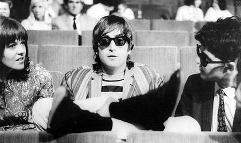 |
The boy who came into Brian’s store to ask for the
Beatles record was only one of several youngsters to do so. However, because
Brian Epstein opened his book ‘A Cellarful of Noise’ naming him as Raymond
Jones, an entire myth has developed that Brian had never heard of The Beatles
until that time. Although I was aware that Brian didn’t like to apportion
credit to anyone I was surprised at the introduction to his book.
He’d taken me to lunch at the Basnett Bar on a couple of occasions to discuss
the local music scene, and individual groups in particular, and he has admitted
in print that it was me he phoned to arrange for him to visit the 'Cavern'
where he saw The Beatles for the first time. Although Brian wrote that he
hadn’t heard of The Beatles until Raymond Jones came into his store on October
28th 1961, not only had he been discussing them with me for months, after
reading about them in almost every issue of 'Mersey Beat', but The Beatles
had been going into Nems after their lunchtime sessions at the 'Cavern'
since March. They used to go into the record booths and listen to the ‘B’ sides of American records. According to Pete Best, Brian Epstein noticed them then and had asked who they were. Also, prior to the Raymond Jones request, Brian had been selling tickets to the 'Operation Big Beat' event at the Tower Ballroom, in which The Beatles were the headliners, and he had a poster to that effect displayed in the store. As Paul McCartney wrote in his autobiography. . . . . The story of how Brian Epstein visited the 'Cavern' and was so entranced by the leather-clad boys cavorting on stage that he asked if he could manage them is well-known. As Brian’s autobiography ‘A Cellarful of Noise’ was ghosted for him by Derek Taylor at the height of 'Beatlemania' and he hardly had time to read it, let alone correct any errors, it cannot be trusted on matters of detail. |
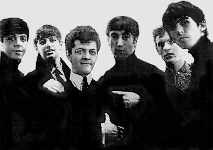 |
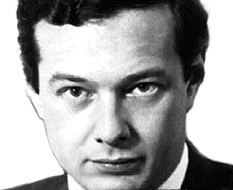 |
The account in the book about Brian being intrigued when three people in
two days came into his record shop and asked for ‘My Bonnie’ by The Beatles,
causing him to set out to find this elusive record by an unknown German
group, is a good story – but it is simply not true.
Brian knew perfectly well who The Beatles were – they were on the front
page of the second issue of 'Mersey Beat', the local music paper. Brian
sold twelve dozen copies of that issue - so many that he invited the editor,
Bill Harry, into his office for a drink to discuss why it was selling so
well and to ask if he could write a record review column for it.
He is unlikely to have missed the ‘Beatles Sign Recording Contract’ banner
headline reporting their session with Tony Sheridan for Bert Kaempfert nor,
with his penchant for rough boys, is it likely that he passed over the photograph
of the leather-clad Beatles without giving them a second glance.
Despite Virginia and I having virtually no funds at all, we still felt that we should contribute to charity and did so by placing free charity ads at the side of the cover title. I don’t know of any other newspapers which have done that. In some ways I shouldn’t have been surprised that the entire print run of 5,000 copies of issue number one completely sold out as there had been no previous publication quite like it. It was the first 'alternative' music newspaper, completely different from the standard music weeklies such as the 'New Musical Express' and 'Melody Maker', which restricted their editorial to current chart acts. In addition, it became the voice of the young people, as no other paper specifically appealed to the youth on Merseyside like 'Mersey Beat', and it also surprised everyone because no one had realised just how extensive the music scene on Merseyside really was and the paper was to become the catalyst for a Merseyside 'musical explosion' which was to have far-reaching effects with the emergence of The Beatles. Obviously, since the members of The Beatles had been my friends since 1957 from the art college/Liverpool Institute days, and since they were now regulars at 'The Jac', they were the ones I was going to plug most in the paper, particularly because of my close relationship with John and Stu, although I was to see little of Stu again as he’d settled in Hamburg. John was actually thrilled that I’d published his piece about The Beatles without changing a single word. He was also surprised, because when he’d given me the piece he’d seemed embarrassed, as if I’d regard it as a piece of rubbish and not publish it. He was so delighted that he came into the office with a huge bundle of material, most everything he’d ever written or drawn, and said that I could have it - it was mine to do with as I wished. |
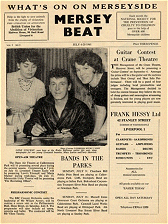 |
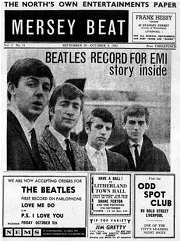 |
I loved the stuff - it appealed to my own sense of humour. I picked out
some of the smaller items and decided to print them as a regular column.
As there was a humorous column in the 'Daily Express' newspaper by 'Beachcomber'
I decided to give John’s works a pseudonym: ‘Beatcomber.’ This pleased him
even further and he wrote some pieces especially for me, one of which was
a satire on my ‘Entertainment Page.’ He also dug into his own pocket to
pay for classified adverts (at 4d a word) in which he also utilised his
‘fractured English’ wordplay.
Soon Virginia and I were able to move from the attic down to the next floor
with two offices. We had a friend, Tim McCoy, build us a counter and Steve
Day (leader of The Drifters) recalls seeing John Lennon come up the stairs,
leap over the counter and begin to throw papers all over the place! John
and Paul used to visit the office regularly to help out and Ringo Starr
of the Hurricanes used to drop in when he was on his way to the dole office
in Renshaw St. Among the numerous other visitors was Geoff Hughes, a member of 'The Travellers', who worked in the car showroom next door to us (Geoff went on to star in TV series such as ‘Coronation Street’, ‘Keeping up Appearances’, ‘The Royle Family’ and ‘Heartbeat’). Another regular was the late Norman Beaton, who also found fame on television. In fact, the office became something of an unofficial office for the entire Mersey scene and Brian Epstein, Jimmy Tarbuck and many others used to gather for a chat and then pop next door to the Renshaw Arms pub. Following the move I looked in the desk drawer where I’d kept all of John’s writings – but it was empty! - all his work had been lost during the move! Virginia and I told John that evening in the 'Blue Angel' club and he cried on her shoulder. John wasn’t the only columnist. Another friend, Bernie Falk, wrote ‘The Moving Finger.’ Bernie became a prominent TV personality but died of a heart attack some years ago. Of particular note was 'Cavern' compere Bob Wooler who penned the ‘Roving I’ columns. Bob Azurdia and Geoff Leack were other columnists and, sadly, the two Bobs, Bernie, and Geoff have all passed away. Virginia and I were now in a position to introduce more photographs into the publication and, apart from the range of Dick Mathews' photos he’d taken for us at the Cavern, we did a deal with a number of other photographers. These included Les Chadwick (under the name Peter Kaye), Harry Watmough, Barry Farrell and Graham Spencer, commissioning them to take photo sessions exclusively for me in exchange for display and classified advertisements, publicity in the paper, the chance to sell the photographs – and with me sending groups to them for photo sessions. |
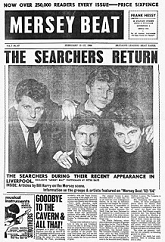 |
|
I
also encouraged the musicians to write for the paper to express their experiences
to the readers.
Mike Hart, Mal Jefferson, The Bluejeans, The Merseybeats and other musicians
became regular correspondents. I was also staggered when Brian Epstein ordered
twelve dozen copies of issue number two. This was an incredible amount of
copies for a single outlet to order and we sat down in his office while
he went through the newspaper, amazed that this active musical scene was
occurring literally on his own doorstep. He asked if he could become my
record reviewer and his reviews, under the title ‘Stop The World And Listen
To Everything In It - Brian Epstein of Nems’ began in issue number three
on 3rd August 1961. He
also took out advertisements - it’s interesting to note that it is a 'Nems'
advert that appears on the full page feature by Bob Wooler about The Beatles
that appeared in the August 31st 1961 issue of Mersey Beat. It began: |
|
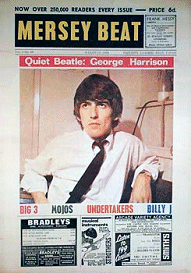 |
“
Why do you think The Beatles are so popular? Many people, many times, have
asked me this question since that fantastic night (Tuesday 27th December
1960) at Litherland Town Hall when the impact of the act was first felt
on this side of the river. ” He went on to describe them as “the stuff that screams are made of” and ended “Truly a phenomenon…such are the fantastic Beatles. I don’t think anything like them will happen again.” This is an absolute classic article because, considering the time it was written, it was most prophetic. Talking of Bob, he came into the office one day to complain that I was publicising The Beatles too much. He said that other groups were complaining and saying that I should change the name of the paper to 'Mersey Beatle'. I kept that in mind and some time later included a regular page actually called 'Mersey Beatle'. Bob also brought along Tony Crane and Billy Kinsley who had been leading a group called The Mavericks. He suggested that I give them permission to name themselves after the paper, pointing out that a group called The Melody Makers already provided free publicity for that publication. At the time, having registered 'Mersey Beat' as a limited company, the law protected the name from being used by anyone else. I agreed to them calling themselves The Mersey Beats (later they truncated it to 'Merseybeats'). Brian Epstein also asked me if he could name some concerts he was promoting as 'Mersey Beat Showcase', which I also agreed to. When The Beatles, Searchers, Gerry, Billy J., Cilla and other artists began to hit the charts (in 1963 Liverpool acts dominated the No.1 position in the British charts throughout the year) the media described the music as ‘The Mersey Sound’ or ‘The Liverpool Sound.’ The music was never called 'Mersey Beat' at the time the publication actually existed, so it was something of a surprise when people began to refer to it as 'Mersey Beat' from the late Sixties, which makes it somewhat of an anachronism when referring to the sound. There is no doubt that the 'Cavern' became the most famous club in the world during the Sixties and the club owner Ray McFall needs to be acclaimed for everything he did. However, the major success of the 'Cavern' tends to cloud the vitality of the other Merseyside venues, just as The Beatles overshadowed every other act. The Beatles, under their original name of The Quarry Men (two words not one), actually had their first residency in a club which also had six letters in its name and beginning with the letter C – no, it’s not the 'Cavern', it’s the 'Casbah' - which was also the first venue the Beatles appeared in on their return from their first German trip. A highlight in the Beatles chronology is their appearance at Litherland Town Hall on Tuesday 27th December 1960. Fresh from Hamburg, they astonished the audience with their new dynamism. |
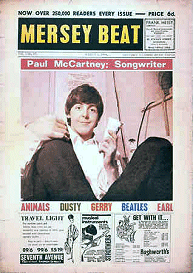 |
Brian Kelly was the promoter of this event and he booked them for a further
35 dates at his various other venues, mainly Litherland and Aintree Institute.
Kelly, who also promoted at Lathom Hall, Savoy Hall and Alexandra Hall booked
The Beatles more times than any other local promoter with the exception
of Ray McFall. His contribution as a major Merseyside promoter has never
really been acknowledged as he died many years ago. Incidentally, Kelly
had originally booked the Silver Beats (as they then called themselves)
on Saturday 4th May 1960 at Lathom Hall.
|
 |
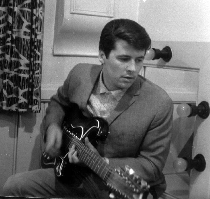 |
Dodd
promoted dances on the Wirral and booked The Silver Beetles at The Institute,
Neston and The Grosvenor Ballroom, Birkenhead prior to their first trip
to Hamburg. Also ‘over the water’ was the Tower Ballroom, the setting for
major promotions by Sam Leach and Brian Epstein. It must be admitted that
one of the reasons for the growth of the Mersey Sound was the proliferation
of venues for groups throughout Merseyside. Apart from the venues mentioned,
they played at New Brighton Swimming Baths, the Silver Blades Ice Rink,
Allerton Synagogue, The Majestic Ballroom in Birkenhead, The Grafton Ballroom,
The Locarno Ballroom, Knotty Ash Village Hall, St John’s Hall in Crosby,
Kingsway Club in Southport, David Lewis club, Mossway Hall, The Odd Spot,
The Rialto Ballroom, Floral Hall in Southport, La Scala Ballroom in Runcorn,
The Plaza in St Helens and scores of others. In the centre of Liverpool, the Cavern’s main rival was the Iron Door Club, itself formerly a jazz club, 'The Storyville'. As the Cavern became known as the home of The Beatles, the Iron Door was known as the home of The Searchers. The Mardi Gras was a particularly large and exciting venue in Mount Pleasant, run by Jim Ireland, who also managed The Swinging Bluejeans, The Escorts, Earl Preston and Cy Tucker, in addition to another city centre venue, The Downbeat club. The repertoires of the groups were based on American rock‘n’roll and R&B numbers and they used to compete to see who could be first with new songs. Among them were ‘Little Egypt’, ‘Poison Ivy’, ‘Twist & Shout’, ‘Memphis Tennessee’, ‘All Around The World’, ‘Stupidity’, ‘Dr Feelgood’, ‘Skinnie Minnie’, ‘Yakety Yak’, ‘Alley Oop’, ‘Good Golly Miss Molly’, ‘Magic Potion’, ‘Johnny B. Goode’, ‘C’mon Everybody’, ‘Roll Over Beethoven’, ‘Searchin’’, ‘Whole Lotta Shakin’’ and ‘Boney Moronie.’ Their heroes were Elvis, Buddy Holly, Little Richard, Eddie Cochran, Carl Perkins and Chuck Berry. Oriole Records issued Tamla Motown Records on their Oriole American label and found that their biggest sales took place on Merseyside. I used to include a 'Motown' page, with features on artists such as Little Stevie Wonder, The Contours, Mary Wells and The Miracles. The Beatles and other groups used to include Motown numbers such as ‘Money,’ ‘Beechwood 45789’, ‘Do You Love Me’, ‘Shake Sherry’ and ‘You Really Got A Hold On Me’ in their repertoires. |
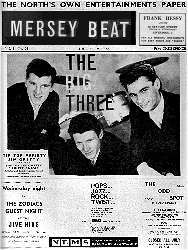 |
As
the Liverpool groups reinterpreted the numbers and performed them in their
own style, I referred to it as the 'Mersey-Motown Sound'.All of the numbers
in the repertoire of The Beatles and other groups were readily available
and could be bought in local record stores. They weren’t brought in by ‘Cunard
Yanks’ as some sources claim. Out of more than five hundred groups and artists who performed on the Mersey scene between 1958 and 1965, only the chart artists are generally widely known – The Beatles, The Searchers, Gerry & The Pacemakers, Billy J. Kramer and The Dakotas, Cilla Black, The Fourmost and The Swinging Bluejeans. There were, of course, many others who had the potential to become international names but never achieved the success they deserved. They included The Big Three, Kingsize Taylor & The Dominoes, Rory Storm & The Hurricanes, The Remo Four, Beryl Marsden, Faron’s Flamingos, The Chants, Jimmy Campbell, Steve Aldo, The Strangers, The Dennisons, The Escorts, The Undertakers, Derry Wilkie, The Roadrunners and David Garrick. The success of 'Mersey Beat' led to many other similar newspapers spreading throughout the provinces from Southend to Glasgow, one of the first being 'Midland Beat' in Birmingham. Aspiring editors contacted me for help and one of them, who was to produce 'Western Scene' in Bristol, spent a week with me in Liverpool while I showed him all the ropes. I counted over 20 publications which were based directly on 'Mersey Beat', which must have made it the most-imitated newspaper in the world at the time. As for 'Mersey Beat' itself, by 1965 London had re-established itself as the musical centre and A&R men were combing all the other cities – Manchester, Birmingham, Sheffield, Newcastle, with Liverpool (mistakenly) being regarded as having been drained of all its main talent. Brian Epstein wanted me to finish with 'Mersey Beat' and launch a national music paper for him, so I coined the phrase 'Music Echo', merging 'Mersey Beat' into it. |
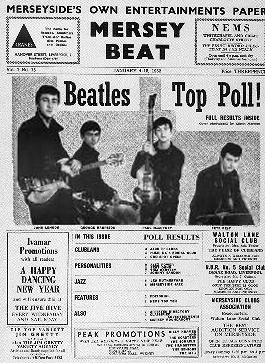 |
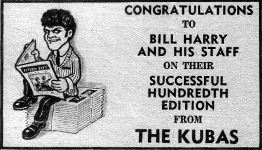 |
I
had, of course, been promoting groups from the provinces for a number of
years, particularly from the cities mentioned above. Unfortunately,
Brian seemed to have the wrong idea of what a music paper should be. Although
promising me full editorial control, he began commissioning the type of
material which I considered ‘naff.’ Without consulting me he hired a female
P.R. in London to write a fashion column, a London club D.J. to write a
gossip column and I was suddenly flooded with material and photographs which
I considered would be disastrous for the paper and would provide no competition
to the London 'majors'. I told Brian I could no longer work on 'Music Echo' and so I left, to become a P.R. myself, and Virginia and I then moved to London where, over the next 18 years, I represented about 30 major artists including The Hollies, The Kinks, Pink Floyd, Jethro Tull, Procol Harum, Ten Years After, David Bowie, The Beach Boys, The Pretty Things, Led Zeppelin, Supertramp, Nazareth, Suzi Quatro, Hot Chocolate and Kim Wilde. |
|
|
All
Original Material Copyright SixtiesCity
Other individual owner copyrights may apply to Photographic Images |